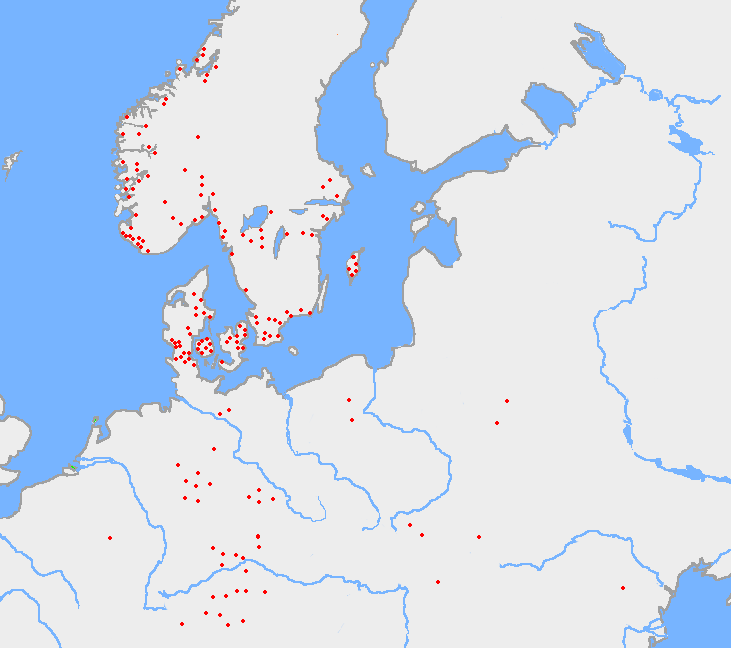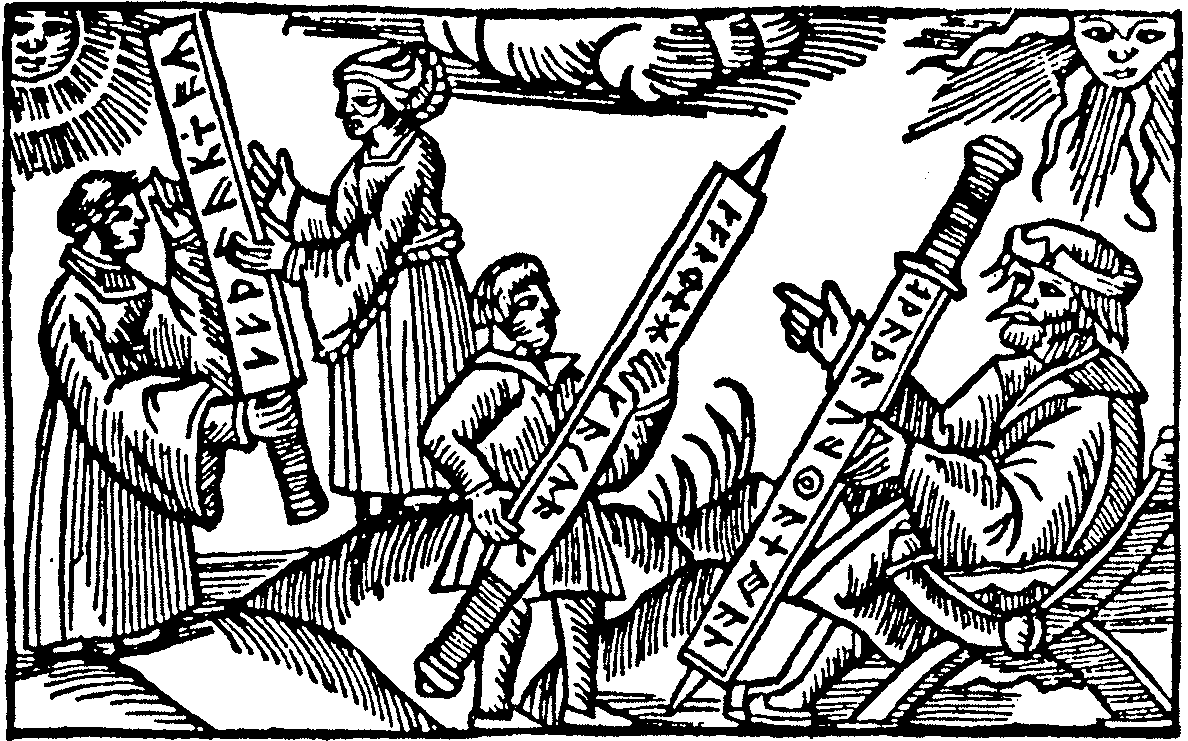|
Jēran
Jera (also Jeran, Jeraz, Yera) is the conventional name of the ''j''-rune of the Elder Futhark, from a reconstructed Common Germanic stem (linguistics), stem 'Cf. Page (2005:15). The word may have been either neuter or masculine in Common Germanic. meaning "harvest, (good) year". The corresponding letter of the Gothic alphabet is Gothic , named '':wikt:𐌾𐌴𐍂, 𐌾𐌴𐍂 (jēr)'', also expressing /j/. The Elder Futhark rune gives rise to the Anglo-Frisian runes, Anglo-Frisian , named ''gēr'' , and , named ''ior'', and to the Younger Futhark ''ár'' rune , which stands for , as the phoneme disappears in late Proto-Norse. Note that also can be a variation of Medieval runes, dotted Isaz used for ; e.g. in Dalecarlian runes. Name The reconstructed Common Germanic name ' is the origin of English wikt:year, year (Old English ''wikt:gear#Old English, ġēar''). In contrast to the modern word, it had a meaning of "season" and specifically "harvest", and hence "plenty, ... [...More Info...] [...Related Items...] OR: [Wikipedia] [Google] [Baidu] |
Anglo-Saxon Runes
Anglo-Saxon runes or Anglo-Frisian runes are runes that were used by the Anglo-Saxons and Medieval Frisians (collectively called Anglo-Frisians) as an alphabet in their native writing system, recording both Old English and Old Frisian (, ᚱᚢᚾᚪ, "rune"). Today, the characters are known collectively as the futhorc (ᚠᚢᚦᚩᚱᚳ, ''fuþorc'') from the sound values of the first six runes. The futhorc was a development from the older Germanic peoples, co-Germanic 24-character runic alphabet, known today as Elder Futhark, expanding to 28 characters in its older form and up to 34 characters in its younger form. In contemporary Scandinavia, the Elder Futhark developed into a shorter 16-character alphabet, today simply called Younger Futhark. Use of the Anglo-Frisian runes is likely to have started in the 5th century onward and they continued to see use into the High Middle Ages. They were later accompanied and eventually overtaken by the Old English Latin alphabet introdu ... [...More Info...] [...Related Items...] OR: [Wikipedia] [Google] [Baidu] |
Elder Futhark
The Elder Futhark (or Fuþark, ), also known as the Older Futhark, Old Futhark, or Germanic Futhark, is the oldest form of the runic alphabets. It was a writing system used by Germanic peoples for Northwest Germanic dialects in the Migration Period. Inscriptions are found on artifacts including jewelry, amulets, plateware, tools, and weapons, as well as runestones, from the 2nd to the 8th centuries. In Scandinavia, beginning in the late 8th century, the script was simplified to the Younger Futhark, while the Anglo-Saxons and Frisians instead extended it, giving rise to the Anglo-Saxon runes, Anglo-Saxon futhorc. Both the Anglo-Saxon futhorc and the Younger Futhark remained in use during the Early Middle Ages, Early and the High Middle Ages respectively, but knowledge of how to read the Elder Futhark was forgotten until 1865, when it was deciphered by Norwegian scholar Sophus Bugge. Description The Elder Futhark is named after the initial phoneme of the first six rune names: /f/ ... [...More Info...] [...Related Items...] OR: [Wikipedia] [Google] [Baidu] |
Medieval Runes
The medieval runes, or the futhork, was a Scandinavian runic alphabet that evolved from the Younger Futhark after the introduction of ''stung'' (or ''dotted'') runes at the end of the Viking Age. These stung runes were regular runes with the addition of either a dot diacritic or bar diacritic to indicate that the rune stood for one of its secondary sounds (so an i rune could become an e rune or a j rune when stung). The medieval futhork was fully formed in the early 13th century. Due to the expansion of its character inventory, it was essentially possible to have each character in an inscription correspond to only one phoneme, something which was virtually impossible in Younger Futhark with its small inventory of 16 runes.Enoksen 1998:137 Medieval runes were in use throughout Scandinavia during the Middle Ages, and provided the basis for runology beginning in the 16th century. History Towards the end of the 11th century, the runic alphabet met competition from the introduced La ... [...More Info...] [...Related Items...] OR: [Wikipedia] [Google] [Baidu] |
Dalecarlian Runes
The Dalecarlian runes, or dalrunes (), was a late version of the runic script that was in use in the Swedish province of Dalarna until the 20th century. The province has consequently been called the "last stronghold of the Germanic script". History and usage When Carl Linnaeus visited Älvdalen in Dalarna in 1734, he made the following note in his diary: The Dalecarlian runes were derived from the medieval runes, but the runic letters were combined with Latin ones, and Latin letters would progressively replace the runes. At the end of the 16th century, the Dalecarlian runic inventory was almost exclusively runic, but during the following centuries more and more individual runes were replaced with Latin characters. In its last stage almost every rune had been replaced with a Latin letter, or with special versions that were influenced by Latin characters. Although the use of runes in Dalarna is an ancient tradition, the oldest dated inscription is from the last years of the 16 ... [...More Info...] [...Related Items...] OR: [Wikipedia] [Google] [Baidu] |
Gear
A gear or gearwheel is a rotating machine part typically used to transmit rotational motion and/or torque by means of a series of teeth that engage with compatible teeth of another gear or other part. The teeth can be integral saliences or cavities machined on the part, or separate pegs inserted into it. In the latter case, the gear is usually called a cogwheel. A cog may be one of those pegsDefinition of "cog" in the ''Oxford Learner's Dictionary'' online. Accessed on 2024-07-29.Definition of "cog" in the ''Merriam-Webster Dictionary'' online. Accessed on 2024-07-29. [...More Info...] [...Related Items...] OR: [Wikipedia] [Google] [Baidu] |
Ancient Greek
Ancient Greek (, ; ) includes the forms of the Greek language used in ancient Greece and the classical antiquity, ancient world from around 1500 BC to 300 BC. It is often roughly divided into the following periods: Mycenaean Greek (), Greek Dark Ages, Dark Ages (), the Archaic Greece, Archaic or Homeric Greek, Homeric period (), and the Classical Greece, Classical period (). Ancient Greek was the language of Homer and of fifth-century Athens, fifth-century Athenian historians, playwrights, and Ancient Greek philosophy, philosophers. It has contributed many words to English vocabulary and has been a standard subject of study in educational institutions of the Western world since the Renaissance. This article primarily contains information about the Homeric Greek, Epic and Classical periods of the language, which are the best-attested periods and considered most typical of Ancient Greek. From the Hellenistic period (), Ancient Greek was followed by Koine Greek, which is regar ... [...More Info...] [...Related Items...] OR: [Wikipedia] [Google] [Baidu] |
Old East Slavic
Old East Slavic (traditionally also Old Russian) was a language (or a group of dialects) used by the East Slavs from the 7th or 8th century to the 13th or 14th century, until it diverged into the Russian language, Russian and Ruthenian language, Ruthenian languages. Ruthenian eventually evolved into the Belarusian language, Belarusian, Rusyn language, Rusyn, and Ukrainian language, Ukrainian languages. Terminology The term ''Old East Slavic'' is used in reference to the modern family of East Slavic languages. However, it is not universally applied. The language is also traditionally known as ''Old Russian''; however, the term may be viewed as anachronistic, because the initial stages of the language which it denotes predate the dialectal divisions marking the nascent distinction between modern East Slavic languages, therefore a number of authors have proposed using ''Old East Slavic'' (or ''Common East Slavic'') as a more appropriate term. ''Old Russian'' is also used to descr ... [...More Info...] [...Related Items...] OR: [Wikipedia] [Google] [Baidu] |
Avestan
Avestan ( ) is the liturgical language of Zoroastrianism. It belongs to the Iranian languages, Iranian branch of the Indo-European languages, Indo-European language family and was First language, originally spoken during the Avestan period, Old Iranian period ( – 400 BCE) by the Arya (Iran), Iranians living in the Avestan geography, eastern portion of Greater Iran. After Avestan Language death, became extinct, its religious texts were first transmitted Oral literature, orally until being collected and Sasanian Avesta, put into writing during the Sasanian empire, Sasanian period ( – 500 CE). The Avesta, extant material falls into two Variety (linguistics), groups: Old Avestan ( – 900 BCE) and Younger Avestan ( – 400 BCE). The immediate ancestor of Old Avestan was the Proto-Iranian language, a sister language to the Proto-Indo-Aryan language, with both having developed from the earlier Proto-Indo-Iranian language. As such, Old Avestan is quite close in both grammar and lexi ... [...More Info...] [...Related Items...] OR: [Wikipedia] [Google] [Baidu] |
History Of The Latin Alphabet
The Latin script is the most widely used alphabet, alphabetic writing system in the world. It is the standard script of the English language and is often referred to simply as "the alphabet" in English. It is a true alphabet which originated in the 7th century BC in Italy and has changed continually over the last 2,500 years. It has roots in the Semitic alphabet and its offshoot alphabets, the Phoenician alphabet, Phoenician, Greek alphabet, Greek, and Etruscan alphabet, Etruscan. The phonetic values of some letters Latin spelling and pronunciation, changed, some letters were lost and gained, and several writing styles ("hands") developed. Two such styles, the minuscule cursive, minuscule and majuscule hands, were combined into one script with alternate forms for the lower and upper Letter case, case letters. Modern uppercase letters differ only slightly from their classical counterparts, and there are few regional variants. Summary of evolution The Latin alphabet started out as u ... [...More Info...] [...Related Items...] OR: [Wikipedia] [Google] [Baidu] |
Vimose Inscriptions
The Vimose inscriptions (), found on the island of Funen, Denmark, include some of the oldest datable Elder Futhark runic inscriptions in early Proto-Norse or late Proto-Germanic from the 2nd to 3rd century in the Scandinavian Iron Age and were written in the time of the Roman Empire The Roman Empire ruled the Mediterranean and much of Europe, Western Asia and North Africa. The Roman people, Romans conquered most of this during the Roman Republic, Republic, and it was ruled by emperors following Octavian's assumption of .... *Vimose Comb (, considered the oldest known datable runic inscription altogether): harja (ᚺᚨᚱᛃᚨ) *Vimose Buckle () aadagasu =? ansuz-a(n)dag-a(n)su / laasauwija =? la-a au-wija; *Vimose Chape (): mariha , , la / makija; possibly "Mari (the famous one) is the sword of Alla" *Vimose Woodplane () talijo gisai oj: wiliz .a o ../ tkbis: hleuno: an regu * Vimose Sheathplate (): ; possibly "son/descendant of Awa" *Vimose Spearhead: gni ... [...More Info...] [...Related Items...] OR: [Wikipedia] [Google] [Baidu] |





